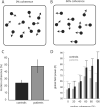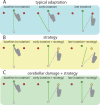Moving, sensing and learning with cerebellar damage
- PMID: 21733673
- PMCID: PMC3177958
- DOI: 10.1016/j.conb.2011.06.007
Moving, sensing and learning with cerebellar damage
Abstract
The cerebellum is a subcortical brain structure that is essential for learning and controlling movement. Recent work shows that the cerebellum also plays a role in certain perceptual abilities, beyond what would be expected secondary to poor movement control. This review covers these and other recent advances, focusing on how cerebellar damage affects human abilities ranging from sensory perception to movement control and motor learning.
Copyright © 2011 Elsevier Ltd. All rights reserved.
Figures



References
-
- Strick PL, Dum RP, Fiez JA. Cerebellum and nonmotor function. Ann Rev Neurosci. 2009;32:413–434. - PubMed
-
- Ivry RB, Spencer RM. The neural representation of time. Curr Opin Neurobiol. 2004;14:225–32. - PubMed
-
- Wolpert DM, Ghahramani Z, Jordan MI. An internal model for sensorimotor integration. Science. 1995;269:1880–2. - PubMed
Publication types
MeSH terms
Grants and funding
LinkOut - more resources
Full Text Sources
Medical

